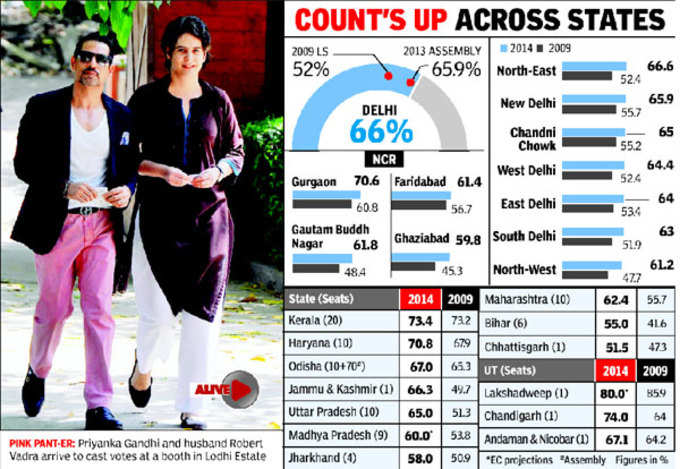 NEW DELHI: A turnout of 64.8% in Delhi – which could go up to 66% when figures are finally tallied – showed just how seriously this election was taken by the city voters on Thursday. Such a high turnout, up almost 12 percentage points from the 2009
NEW DELHI: A turnout of 64.8% in Delhi – which could go up to 66% when figures are finally tallied – showed just how seriously this election was taken by the city voters on Thursday. Such a high turnout, up almost 12 percentage points from the 2009 Voter enthusiasm was evident from 7am, when polling began, with queues building up at booths. When polling came to a close at 6pm, there were still voters inside several polling centres. Classes and masses went all out to vote in a bid to be a part of the 2014 people’s mandate.
It’s risky to interpret the vote from conversations with voters, picked randomly. Still, here’s what the TOI team of reporters, which had fanned across the city since morning, sensed.
First, there was a clear mood for change. There could be a dispute as to who will gain from this: the BJP with its leader
Second, despite the presence of Congress in the arena, the fight for the seven Delhi seats appeared to be essentially between BJP and AAP. The ruling party, which blanked its opponents last time, was absent from conversations at booths.

Third, the impressive turnout in middle class constituencies – the main reason for the high overall turnout – was seen as a happy augury for the BJP. Four months ago in the assembly election, this segment had enthusiastically supported AAP. This time its favourite choice seemed to be the BJP.
The poor living in slums and downscale localities, however, didn’t seem to have veered away from AAP, although a few among them said they viewed BJP favourably. From this it seemed that if anyone had benefitted from the 49-day
The Muslim vote, which was supposed to rally behind the non-BJP party best placed to beat BJP, appeared to be divided between AAP and Congress in Chandni Chowk, although a majority seemed to be with the former. In East Delhi, though, it appeared to be going with AAP, although there was a division in Okhla.
The division of Muslim vote could be important for the final outcome. While it can be a force multiplier for AAP in seats where the party is doing well, it may edge out the Congress, dealing it a body blow. This apart, it could work to the advantage of the BJP, which would have been hurt by an anti-Modi consolidation in the community vote.
Image: Thinkstock
